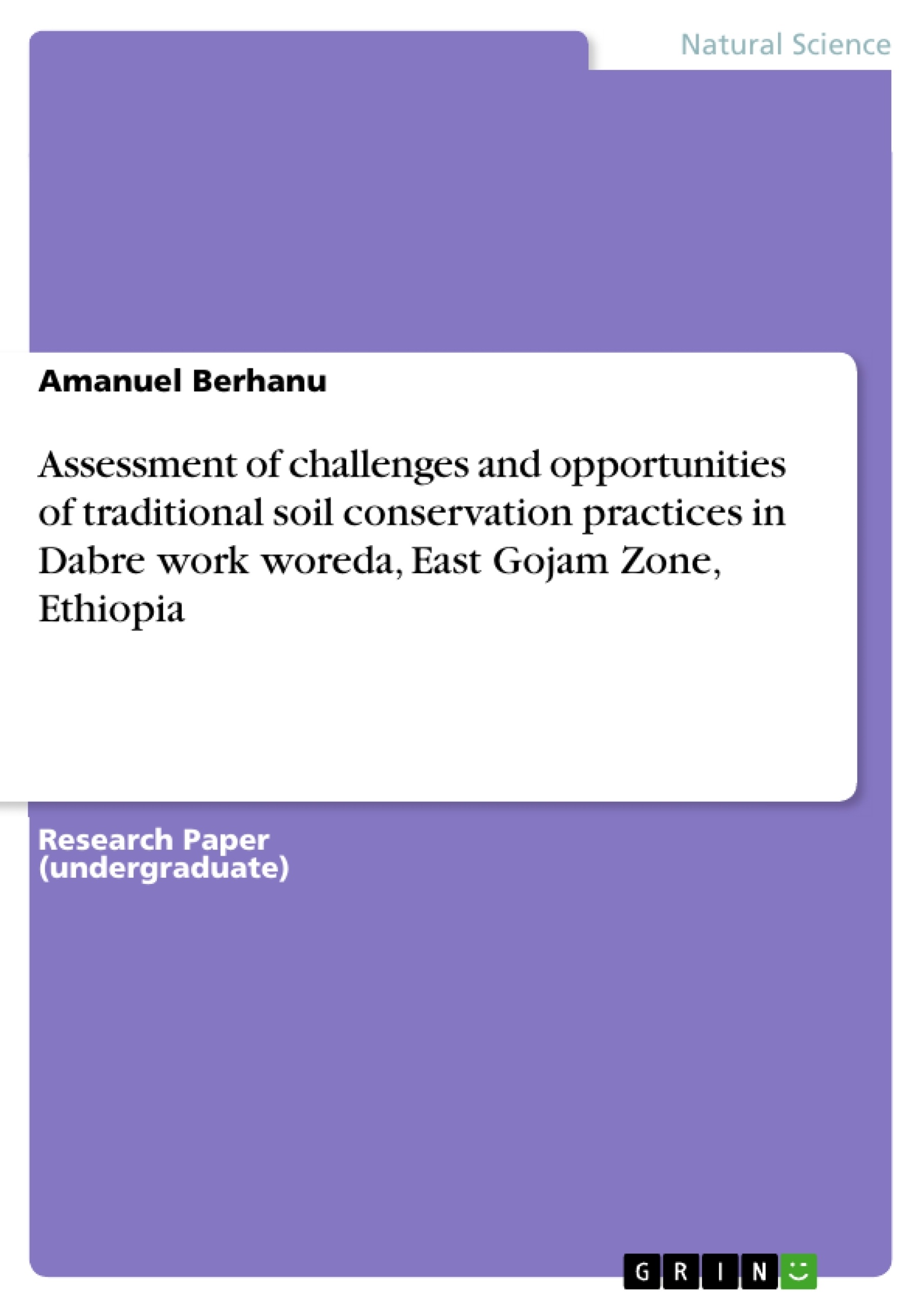The study was conducted in Diyateba kebele and Dijumeti kebeles at Debirework Woreda, East Gojjam zone. The major purpose of the study was to assess the opportunity and challenges of traditional soil conservation practices in Diyateba kebele and Dijumeti kebeles kebele. It also among at investigate the opportunities and challenges of traditional soil conservation practices. The data for this study were collected from both primary and secondary sources by using simple random sampling techniques. The primary data was collected through questionnaires and interviewing farmers who have long history and more experience about the data. The secondary data sources were taken from books and Diyateba kebele and Dijumeti kebele Administrative office.
The study should that the farmers of the study area have a good awareness of the negative effects of soil erosion on socio-economic and environmental aspects of the society. To overcome the negative effects, farmers of the study area have practice several traditional soil conservation measures. These practices are both biological (application of manure, crop rotation) and structural measures (soil or stone bund) to protect soil from and maintain soil fertility. To apply those traditional soil conservation practices there are opportunities like distance from homestead, presence of livestock ,area of cultivated land and absence of inorganic fertilizer. And has challenges like socio-economic, farm institutional and technological challenges. To reduce these problems, there should be improved knowledge of local communities 'towards traditional soil conservation practices.
Inhaltsverzeichnis (Table of Contents)
- Abstract
- 1. INTRODUCTION
- 1.1 Background of the study
- 1.2 Statement of the problem
- 1.3. Objectives of the study
- 1.3.1 General objective
- 1.3.2. Specific objectives
- 1.4 Research questions
- 1.5. Significance of the study
- 1.6 Scope of the study
- 2. LITRATURE REVIEW
- 2.1. Concepts of soil conservation and soil erosion
- 2.1. 1. Soil Erosion
- 2.1.2. Soil conservation
- 2.2. Soil conservation in Ethiopia
- 2.3 Traditional soil conservation methods
- 2.3.1: Soil bund
- 2.3.2: Animal dung
- 2.3.3 Crop Rotation
- 2.3.4. Application of manure
- 2.3.5. Crop rotation
- 2.3.6. Soil or Stone bund
- 2.4. Opportunities of traditional soil conservation practice
- 2.5. Challenges of traditional soil conservation practice
- 2.5.1 Socio cultural challenges
- 3. RESEARCH METHODOLOGY
- 3.1 Description of the Study Area
- 3.2 Research design
- 3.3 Sources and types of Data
- 3.5 Sampling Techniques and Sample Size
- 3.6 Data analysis
- 3.7 Hypothesis of Variables
- 3.7.1 Independent variables
- 3.6.2 Dependent variable
- 4. RESULTS AND DISCUSSION
- 4.1 Descriptive Statistics
- 4.2 Socio-demographic characteristics
- 4.2.1 Sex, Age and marital status of Respondents
- 4.3. Nature, Type and problem of erosion in the study area
- 4.4 Farmers perception on Cause of soil erosion in the study area
- 4.5 Effects of soil erosion in the study area
- 4.6 Traditional soil conservation methods being practiced in the study area
- 4.6.1: Soil bund
- 4.6.2: Animal dung
- 4.6.3 Crop Rotation
- 4.7 Practices of soil and water conservation
- 4.7.1 Traditional Cut-off Drains
- 4.7.2 Traditional waterways
- 4.7.3 Drip irrigation
- 4.8 Challenges of Traditional Soil Conservation Practices in the Study Area
- 4.8.1 Socio cultural challenges
- 4.8.2 Deforestation
- 4.9 Opportunities of Traditional soil conservation practices in the study area
- 5 CONCULISION AND RECOMMENDATION
- 5.1 CONCULISION
- 5.2 Recommendation
- 6. REFERANCES
Zielsetzung und Themenschwerpunkte (Objectives and Key Themes)
The primary goal of this study is to assess the challenges and opportunities of traditional soil conservation practices in Dabre work woreda, East Gojam zone, Ethiopia, with a specific focus on the Diyateba kebele and Dijumeti kebeles. The research aims to identify and analyze the factors influencing the adoption and implementation of these traditional practices, providing valuable insights for improving soil conservation efforts in the region.
- Challenges and opportunities related to traditional soil conservation practices.
- Impact of soil erosion on socio-economic and environmental aspects of the society.
- Effectiveness of traditional soil conservation methods like soil bunding, animal dung application, and crop rotation.
- Socio-cultural, institutional, and technological factors influencing the adoption of traditional practices.
- The importance of community knowledge and awareness for successful soil conservation.
Zusammenfassung der Kapitel (Chapter Summaries)
The study begins by providing a detailed background on the significance of soil conservation in Ethiopia, highlighting the pervasive issue of land degradation and its impact on agricultural productivity. It then delves into a review of existing literature on soil conservation concepts, methods, and challenges, particularly focusing on traditional practices employed in Ethiopia. The research methodology section outlines the study area, data collection techniques, and data analysis methods employed.
The results and discussion section presents findings on socio-demographic characteristics of the study population, the nature and extent of soil erosion in the area, farmers' perceptions of soil erosion causes, and the effects of soil erosion. It further analyzes the traditional soil conservation methods being practiced, including their effectiveness and challenges. The study concludes with a summary of findings, highlighting key challenges and opportunities, and offers recommendations for improving traditional soil conservation practices in the region.
Schlüsselwörter (Keywords)
The study focuses on the challenges and opportunities associated with traditional soil conservation practices in Ethiopia, emphasizing the importance of local knowledge and community participation in sustainable land management. Key terms and concepts include: traditional soil conservation, soil erosion, stone bunds, animal dung, crop rotation, socio-cultural challenges, technological advancements, and community awareness. The research aims to contribute to the understanding of factors influencing the adoption and effectiveness of traditional soil conservation practices, providing valuable insights for developing evidence-based approaches to sustainable land management in the region.
- Quote paper
- Amanuel Berhanu (Author), Assessment of challenges and opportunities of traditional soil conservation practices in Dabre work woreda, East Gojam Zone, Ethiopia, Munich, GRIN Verlag, https://www.hausarbeiten.de/document/1020380


